Comparison of speckle-tracking echocardiography with invasive hemodynamics for the detection of characteristic cardiac dysfunction in type-1 and type-2 diabetic rat models
- PMID: 29338775
- PMCID: PMC5769218
- DOI: 10.1186/s12933-017-0645-0
Comparison of speckle-tracking echocardiography with invasive hemodynamics for the detection of characteristic cardiac dysfunction in type-1 and type-2 diabetic rat models
Abstract
Background: Measurement of systolic and diastolic function in animal models is challenging by conventional non-invasive methods. Therefore, we aimed at comparing speckle-tracking echocardiography (STE)-derived parameters to the indices of left ventricular (LV) pressure-volume (PV) analysis to detect cardiac dysfunction in rat models of type-1 (T1DM) and type-2 (T2DM) diabetes mellitus.
Methods: Rat models of T1DM (induced by 60 mg/kg streptozotocin, n = 8) and T2DM (32-week-old Zucker Diabetic Fatty rats, n = 7) and corresponding control animals (n = 5 and n = 8, respectively) were compared. Echocardiography and LV PV analysis were performed. LV short-axis recordings were used for STE analysis. Global circumferential strain, peak strain rate values in systole (SrS), isovolumic relaxation (SrIVR) and early diastole (SrE) were measured. LV contractility, active relaxation and stiffness were measured by PV analysis.
Results: In T1DM, contractility and active relaxation were deteriorated to a greater extent compared to T2DM. In contrast, diastolic stiffness was impaired in T2DM. Correspondingly, STE described more severe systolic dysfunction in T1DM. Among diastolic STE parameters, SrIVR was more decreased in T1DM, however, SrE was more reduced in T2DM. In T1DM, SrS correlated with contractility, SrIVR with active relaxation, while in T2DM SrE was related to cardiac stiffness, cardiomyocyte diameter and fibrosis.
Conclusions: Strain and strain rate parameters can be valuable and feasible measures to describe the dynamic changes in contractility, active relaxation and LV stiffness in animal models of T1DM and T2DM. STE corresponds to PV analysis and also correlates with markers of histological myocardial remodeling.
Keywords: Cardiac dysfunction; Diabetic cardiomyopathy; HFpEF; HFrEF; Heart failure; Invasive hemodynamics; Murine models; Speckle-tracking echocardiography.
Figures
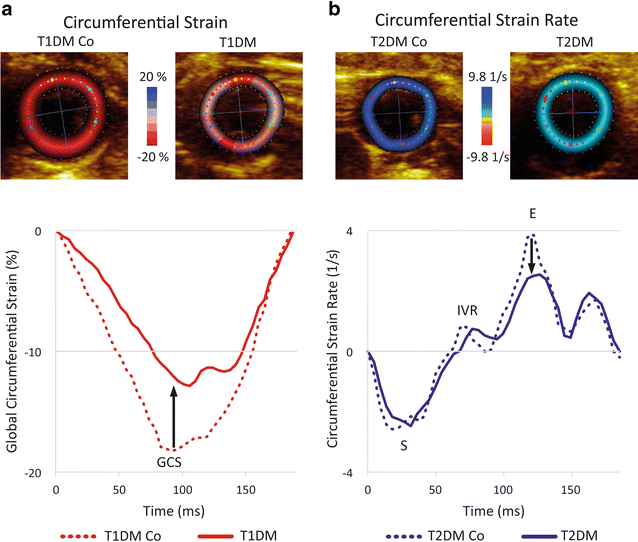
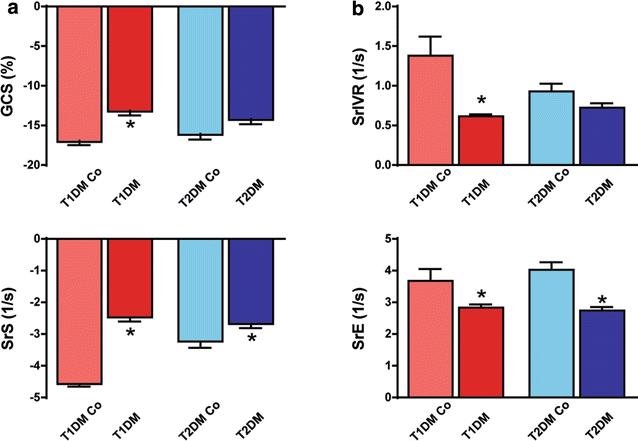
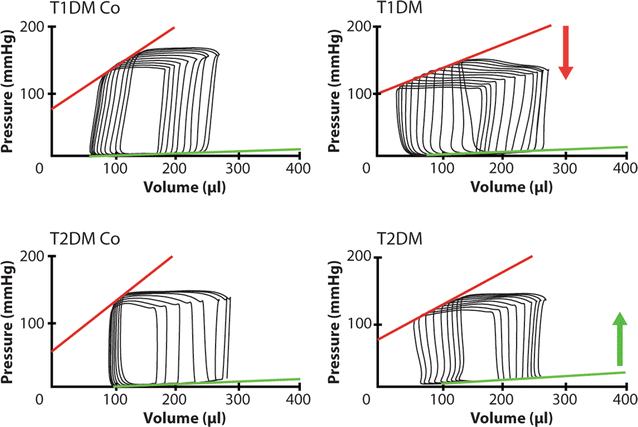
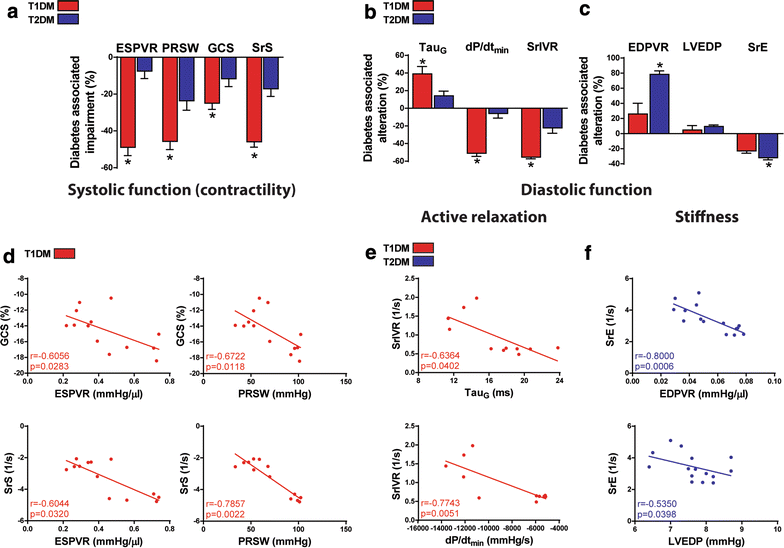
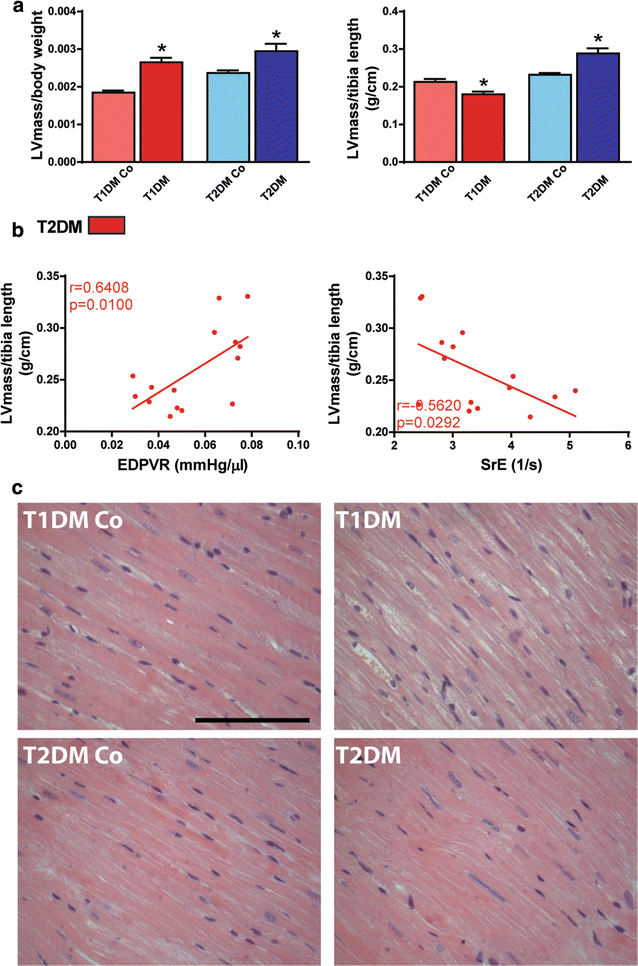

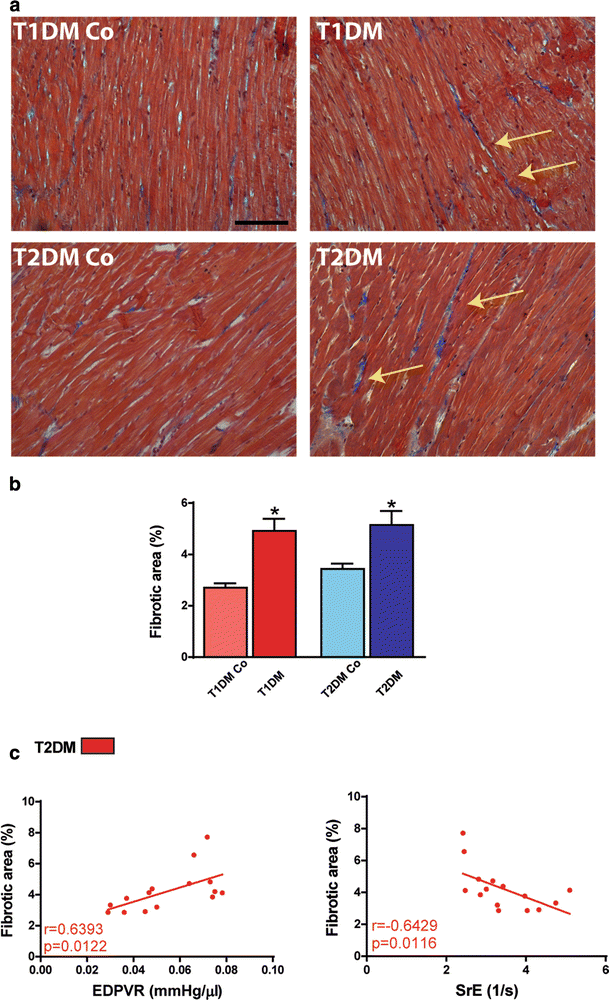
Similar articles
-
Tissue Doppler imaging is a sensitive echocardiographic technique to detect subclinical systolic and diastolic dysfunction of both ventricles in type 1 diabetes mellitus.BMC Cardiovasc Disord. 2016 Apr 22;16:72. doi: 10.1186/s12872-016-0242-2. BMC Cardiovasc Disord. 2016. PMID: 27102111 Free PMC article.
-
A Comprehensive Review of Two-Dimensional Speckle-Tracking Echocardiography in Assessing Right and Left Ventricular Function in Diabetic Patients.Clin Cardiol. 2025 May;48(5):e70153. doi: 10.1002/clc.70153. Clin Cardiol. 2025. PMID: 40405445 Free PMC article. Review.
-
Exercise capacity in diabetes mellitus is predicted by activity status and cardiac size rather than cardiac function: a case control study.Cardiovasc Diabetol. 2018 Mar 23;17(1):44. doi: 10.1186/s12933-018-0688-x. Cardiovasc Diabetol. 2018. PMID: 29571290 Free PMC article.
-
Peak systolic longitudinal rotation: a new tool for detecting left ventricular systolic function in patients with type 2 diabetes mellitus by two-dimensional speckle tracking echocardiography.BMC Cardiovasc Disord. 2019 Jun 7;19(1):137. doi: 10.1186/s12872-019-1119-y. BMC Cardiovasc Disord. 2019. PMID: 31174469 Free PMC article.
-
Assessment of subclinical diabetic cardiomyopathy by speckle-tracking imaging.Eur J Clin Invest. 2021 Apr;51(4):e13475. doi: 10.1111/eci.13475. Epub 2021 Jan 4. Eur J Clin Invest. 2021. PMID: 33326612 Review.
Cited by
-
Impact of acute hyperglycemia on layer-specific left ventricular strain in asymptomatic diabetic patients: an analysis based on two-dimensional speckle tracking echocardiography.Cardiovasc Diabetol. 2019 Jun 3;18(1):68. doi: 10.1186/s12933-019-0876-3. Cardiovasc Diabetol. 2019. PMID: 31159858 Free PMC article.
-
Myocardial work index: a marker of left ventricular contractility in pressure- or volume overload-induced heart failure.ESC Heart Fail. 2021 Jun;8(3):2220-2231. doi: 10.1002/ehf2.13314. Epub 2021 Mar 23. ESC Heart Fail. 2021. PMID: 33754487 Free PMC article.
-
Rodent Models of Dilated Cardiomyopathy and Heart Failure for Translational Investigations and Therapeutic Discovery.Int J Mol Sci. 2023 Feb 5;24(4):3162. doi: 10.3390/ijms24043162. Int J Mol Sci. 2023. PMID: 36834573 Free PMC article. Review.
-
2D/3D CMR tissue tracking versus CMR tagging in the assessment of spontaneous T2DM rhesus monkeys with isolated diastolic dysfunction.BMC Med Imaging. 2018 Nov 26;18(1):47. doi: 10.1186/s12880-018-0288-y. BMC Med Imaging. 2018. PMID: 30477437 Free PMC article.
-
Cirrhotic Cardiomyopathy Following Bile Duct Ligation in Rats-A Matter of Time?Int J Mol Sci. 2023 May 2;24(9):8147. doi: 10.3390/ijms24098147. Int J Mol Sci. 2023. PMID: 37175858 Free PMC article.
References
Publication types
MeSH terms
Substances
Grants and funding
- PD100245/Hungarian Scientific Research Fund/International
- NVKP_16-1-2016-0017/the National Research, Development and Innovation Office/International
- János Bolyai Research Scholarship/Hungarian Academy of Sciences/International
- NTP-NFTÖ-16-0081/Human Resource Support Office/International
- New National Excellence Program; ÚNKP-17-2-I-SE-15/Emberi Eroforrások Minisztériuma/International
LinkOut - more resources
Full Text Sources
Other Literature Sources
Medical
Research Materials

